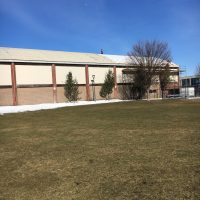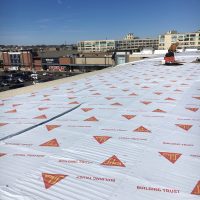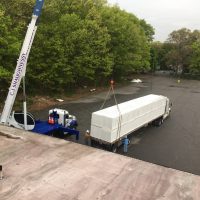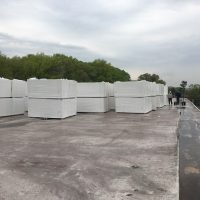FMC News & Events

Getting on Top of Things!
FMC’s arena roof replacement program continues the company’s ongoing commitment to reducing our environmental impact and carbon footprint
Recently FMC completed the installation of a new roof at the Simoni Rink in Cambridge, MA and has started roof replacements at the Buffone Rink in Worcester, MA and the Asiaf Rink in Brockton, MA. By the end of the summer work will begin at the Smead Rink in Springfield, MA. At a total cost of well over half a million dollars at each location this is a significant part of our ongoing capital replacement and revitalization program.

Work begins on the installation of a new roof at the Simoni Rink in Cambridge, MA
We figured this would be a good time to show you the progress and explain why the roof decisions are so important to the future of the arena. So you may be asking yourself “what does a roof have to do with environmental impact?”, in short – A LOT! Many of us think of a roof as just a means to keep rainwater and moisture out of the building. For ice arenas that maintain a cool and dry environment inside for artificial ice, they serve another purpose that is just as critical – reducing heat load on the ice sheet.
The choice of a roofing system is sometimes an afterthought in ice arenas since it is usually not a prominent feature of the building facade, especially in the case of flat roofs that are not even visible. However, it is a very important design decision that has long-term impacts on the quality of ice and carbon emissions attributable to the arena.
The single largest factor impacting both ice quality and energy use is solar heat that warms the rink roof and radiates down to the colder ice surface. This radiation accounts for about 28% of all the heat absorbed by the ice sheet that is then removed by the ice refrigeration plant. This is more than the impact of air temperature and moisture combined!

A vapor barrier being installed over metal decking to prevent moisture from entering the cooler Simoni Rink building.
This impact can be significantly reduced through the selection of a “cool roof” system that has high solar reflectance properties (is able to reflect a high percentage of the sun’s solar energy) as well as good thermal emittance properties (is able to dissipate the heat that is absorbed back into the atmosphere).
As an example, a standard dark (rubber or asphault shingle) roof can reach temperatures of 150 degrees in the heat of the summer, a cool roof will be on average 50 degrees cooler. That makes a big difference for an ice rink. The solar heating effect occurs all year long and not just in warm weather.
EPA has developed a standard for this type of roofing system as part of their Energy Star labeling program. The Energy Star requirement for “cool roof” qualification is a minimum initial solar reflectance of 65% and a maintained minimum reflectance of 50% and a thermal emittance of 75% or greater. The American Society of Heating, Refrigeration and Air Conditioning Engineers sets the minimum solar reflectance at 70% and the emittance at 75%

Snow guards being installed to prevent sliding snow from injuring pedestrians or damaging property at the perimeter of the Simoni Rink.
The roofing system that FMC has chosen for all of our roof replacements meets and exceeds these standards. The system is manufactured by Silka/Sarna and includes a white PVC membrane with high reflectance and emittance properties. The membrane joints are heat welded to provide a monolithic surface that prevents water and vapor from entering the building. Under the membrane is two layers of rigid insulation that provide in excess of R-30 resistance to thermal heat transfer.This type of roofing system is certainly more expensive than a standard commercial roof but that cost is offset over the long term by reduced energy use and a longer lifespan. The new roofs have a 25-year manufacturer’s warranty and we can expect them to last much longer than that with routine maintenance.

Roofing materials arriving at the Buffone Rink in Worcester, MA in advance of the project start.
Let’s put that number into everyday life perspective, it equates to:
Taking 12 passenger vehicles off the road, or
Eliminating 138,313 miles driven annually by an average passenger vehicle, or
Preventing 61,846 pounds of coal burned, or
Providing the annual energy use for 10 average homes, or
Energy used to charge 7,213,637 smart phones
That is a significant positive impact for our environment and community that accumulates and compounds every single year. Combined with FMC’s numerous other initiatives such as super-efficient ice refrigeration systems, LED lighting, condensing boilers and heating systems, energy free water treatment for ice, intelligent computerized controls, etc. FMC is leading the charge to a “greener and cleaner” future for ice arenas.

Work begins to remove the existing roof at the Buffone Rink.
For a standard commercial building, a cool roof will typically reduce energy use by 10% – 15%. However, that impact is much greater for an ice rink maintaining 17,000 square feet of 20 degree ice under that roof. In our year-round facilities we estimate a reduction of between 75,000 to 80,000 kilowatt hours of energy use annually. That is the equivalent of 56 metric tons of greenhouse gas (carbon dioxide) emissions annually per location!
